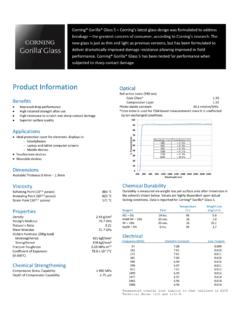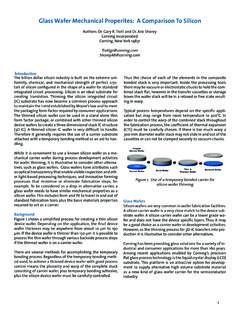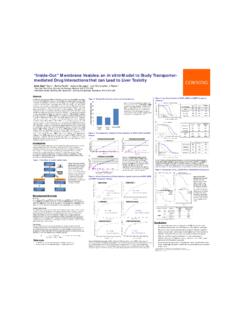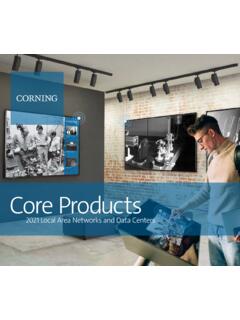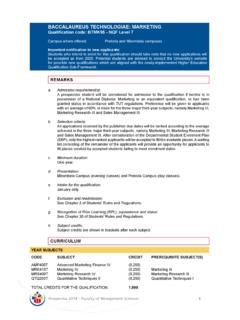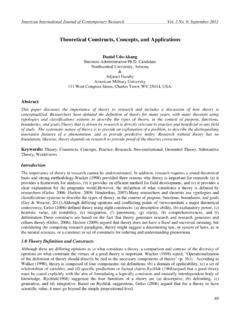Transcription of Fracture Analysis, a Basic Tool to Solve Breakage …
1 Fracture analysis , a Basic tool to Solve Breakage Issues Technical Information Paper TIP 201 Issued: November 2004 Supercedes: August 2000 Toshihiko Ono Corning Japan K. K., Shizuoka Technical Center 12117, Obuchi, Osuka, Ogasa, Shizuoka, 4371397, Japan R. A. Allaire Corning Incorporated, Science and Technology Corning, NY, 14831, USA Biography T. Ono received his B. S. and M. S. degrees in inorganic chemistry from Nagaoka University of Technology, Niigata, Japan, in 1988 and 1990, respectively. In 1990, he joined the Shizuoka Technical Center of Corning Japan K. K.
2 Where he has been engaged in research and development of the finishing technologies of LCD glass substrate and other glasses. He has also proided extensive Fracture analysis support to resolve Breakage problems in Customer processes. Abstract Breakage of glass substrates in LCD manufacturing processes can cause serious problems of productivity and product quality/reliability. It is known that the mechanism associated with Breakage is crack propagation by tensile stress concentration at a damaged point on the glass, which serves as an origin of the Breakage [1]. Elimination of Breakage requires the elimination of the origin and/or reducing the tensile stress.
3 However, this solution can be applied only if location of origins and the kind of the tensile stresses are known. Fracture analysis can provide information of both the tensile stress and the origin of Breakage [2, 3]. This analytical technique gives important information in determining mechanism of Breakage , such as direction of crack propagation, type of the stress, direction of impact and friction, location of the origin. All important information is "memorized" on the broken pieces and can be obtained through microscopic observation. A process where an origin is created is often different from the process where tensile stress is applied.
4 The Breakage mechanism can be understood by combining the information from Fracture analysis with process information. The analysis method will be explained using actual cases. Also, the application of the method for optimization of cell-cutting process will be explained. Glass Breakage The mechanism of glass Breakage is that crack propagates by tensile stress that concentrated at the origin, which is a small damage as cracks on the glass surface, or in the glass body. The relation of the failure stress and size of origin is explained with Eq. 1 [4], TIP 201 | 2 where Y is constant depending on the crack and sample shape, KIC is Fracture toughness, and c is crack size.
5 Glass having larger crack size, c, could broken at lower failure stress. Although the stress applied for glass is lower than the failure stress, crack can be propagated in the atmospheric condition, especially by water. This phenomenon is called Subcritical Crack Growth (SCG) caused by stress corrosion, in which the molecular of water cut the Si-O bonding chemically [5]. The durability of the stress corrosion of glass is indicated with n, crack growth parameter. The glass having large n value is durable for SCG, means has long life reliability. The reliability of several kinds of LCD substrate was studied with Gulati et al, and Code 1737 has the highest n value, has long life reliability entire the LCD substrates [6].
6 1. Origin Origins are typically generated by such mechanisms as indentation, impact, or friction during LCD processes. Actually, there are many opportunities to generate these damages during LCD manufacturing. Indentation damage is irregularly generated when substrates are clamped or chucked on process stages where foreign particles, especially glass particles, are present. Therefore, once the Breakage occurs, appropriate cleaning of the glass chips, etc. in the process is essential to prevent secondary Breakage . Size of the damage as crack by indentation has been studied using Vickers point indentation [7].
7 The general relation between crack size and load is explained with Eq. 2, ICKPc =23 (2) where c is crack size, P is load, KIC is Fracture toughness. is a constant which relates to the material properties and geometry of indenter. Damage by impact, which is principally the same as indentation but loading speed is much faster than that of indentation, is generated mainly on the substrate edge by rapid contact with the supporting rods of the cassette or the alignment pins. This damage is easily generated because stress is localized by point contact. Friction damage is created when placing glass into cassettes, rubbing with the alignment pins, and sliding on the lithography stage.
8 This damage mode usually occurred after impact when the loading direction of the impact is not perpendicular to the surface or edge. When the friction damage is created, it can often be invisible, but becomes visible after acid etching. Stress Tensile stress is the force needed to propagate damage during substrate Breakage . Actually, thermal and mechanical stresses are main sources of tensile stress in the LCD process. Thermal stress for the crack propagation is generated when a heated glass substrate is cooled, which can create tensile stress along the substrate edge. The magnitude of the stress is a function of temperature difference, T, as shown in Eq.
9 3 [8], )1( =TE (3) where is Coefficient of Thermal Expansion (CTE), E is Young s modulus, T is temperature difference between inside and surface of the glass, is Poisson s ratio. is a constant that depends on Bio s constant that relates to the thermal conductivity of the glass and thermal diffusibility of coolant. The constant is when the coolant is air. In addition, CTE mismatch between glass and deposited film material increases the magnitude of stress. Mechanical stress is usually due to bending during handling of the substrate, which is generated when flat glass substrate is warped, frequently due to deposited film substrate CTE mismatch.
10 Bending stress is also generated when warped substrates become flat by vacuum chucking, or clamping. Panel sag during handling also generates bending stresses. Tensile stress by bending is generated not only at the edges, but also at glass surfaces. The tensile stress created by bending can be also calculated with Eq. 4 [9], 22twa = (4) where w is uniform load, a and t are short edge length and thickness of the glass substrate, respectively. is the constant which decided ratio of short/long edges length. Another source of mechanical stress is centrifugal stress by rotation at spin-drying or spin-coating processes.

